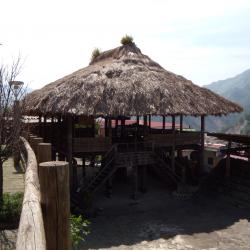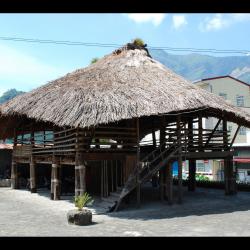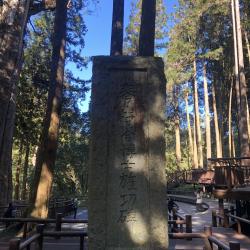Kawai Shitaro visited Alishan in Chiayi in May 1902 and found that Alishan had excellent forestry, good materials and abundant resources. Afterwards, Dr. Hehe's opinions played a key role in several important surveys and forestry management planning. Dr. Kawai played a major role in the development of Alishan forestry. In the 6th year of Showa (1931) March 14, Dr. Kawai passed away in Tokyo, Japan. In honoring his achievements, posterity erected the Kinzan Dr. Kawai Monument in Alishan in November, Showa 7 (1932). It was officially unveiled on February 3, Showa 8 (1933), and designated as a county historic site in 2009.
Tsou

Cou people believe that the existence or failure of a tribe is dependent on the existence or non-existence of the men’s meeting house (Kuba). The housing facilities inside the settlement are the reflection of the operation of the social system. The settlement is the tribal integration center, and its symbolic building is the Kuba. All political, economic, religious, and other public affairs of the tribe must be carried out inside the kuba. The kuba is built in the center or at the entrance of the settlement and is the largest building in the tribe. There is a fire pit in the center of the kuba. Traditionally, the fire must be lit all year round, which symbolizes the continuous life of the tribe. As it has a thatched roof, the fire cannot be too fierce. The square in front of the kuba is a place for tribal ceremonies, judicial arbitration, and other public affairs. There is a sacred tree and an altar below it on the north side of the square. It is a sea fig tree (Yono), which is the ladder for the gods to descend from the sky.

Cou people believe that the existence or failure of a tribe is dependent on the existence or non-existence of the men’s meeting house (Kuba). The housing facilities inside the settlement are the reflection of the operation of the social system. The settlement is the tribal integration center, and its symbolic building is the Kuba. All political, economic, religious, and other public affairs of the tribe must be carried out inside the kuba. The kuba is built in the center or at the entrance of the settlement and is the largest building in the tribe. There is a fire pit in the center of the kuba. Traditionally, the fire must be lit all year round, which symbolizes the continuous life of the tribe. As it has a thatched roof, the fire cannot be too fierce. The square in front of the kuba is a place for tribal ceremonies, judicial arbitration, and other public affairs. There is a sacred tree and an altar below it on the north side of the square. It is a sea fig tree (Yono), which is the ladder for the gods to descend from the sky.
